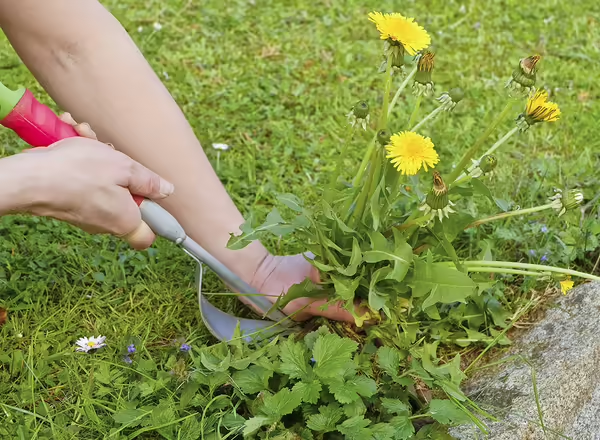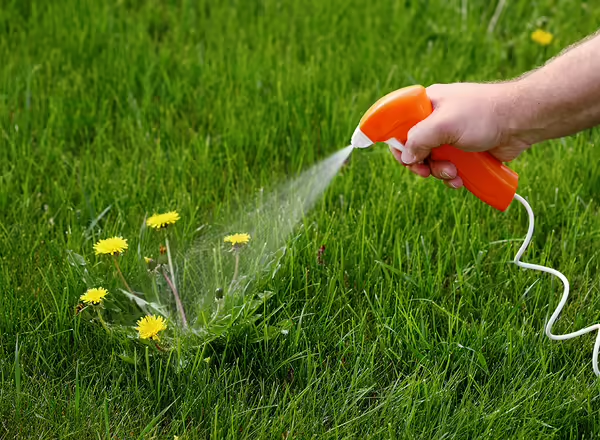
Managing Weeds in Lawns
Many homeowners encounter significant stress and spend lots of money when battling lawn weeds to maintain the appearance of their home or keep pace with their neighbor’s lawn. Please know, that it’s okay to have dandelions, clover, and other plants growing in your lawn. Many professional horticulturists do not fight lawn weeds but rather embrace the diversity offered by these “weeds.” A weed-free lawn is only one model, there are other ways. To put your mind at ease read more about The War on Lawn Weeds: Confronting a Lawn Culture Mindset.
To control a weed, you must know your weeds.
Identifying the weed and trying to determine why it has invaded is the first step in managing broadleaf weeds in lawns. Weeds can be indicators of underlying problems for turf development. For example, ground ivy invades lawns in shade, while knotweed may indicate soil compaction. Assorted weeds may indicate overall poor conditions for lawn grasses and/or poor management.
After identifying the weeds present, step two for controlling weeds should be to review lawn care practices and make adjustments as needed to ensure a good stand of grass. Sound lawn care practices promote a healthy, vigorous turf able to prevent and compete with weed invasions. These practices include proper selection and establishment, fertilization, watering, mowing, thatch management, and related practices. Alter the environment that may be favoring weeds, such as reducing shade or improving poor soil conditions. Are you mowing high (3 to 4-inch cut height), mowing often (following the one-third rule), and keeping those blades sharp? Good! That gives your lawn an advantage over many weeds and may meet the desired lawn quality for many homeowners. If a more manicured lawn is wanted, removal of any remaining weeds is the next step.

Weeds can be removed in two ways, physical control and chemical control. Pulling by hand is one option that physically removes the offending plant. It is important to get all of the plant, as many have underground or above-ground stems (rhizomes or stolons). These stems enable these species to spread quite readily, so if broken or cut, they regrow.
There are several herbicides (weed killers) available for use on lawns. To determine which type of herbicide to use, you need to know what type of weed you’re dealing with and when is it most susceptible to chemical control. Plants can be divided into many different categories such as annuals (live only one growing season) or perennials (live for multiple growing seasons). For this website, we will divide our lawn weeds into broadleaf plants and grasses.

Broadleaf weeds, such as dandelion, clover, and creeping Charlie, are undesirable in turf because of the obvious differences in leaf shape, growth habit, and flower shape and color.
Some broadleaf weeds have an annual lifecycle such as chickweed or henbit, which germinate in the fall and then flower and go to seed in the spring. Perennial broadleaf weeds such as dandelion or clover often earn the greatest contempt from those seeking manicured lawns.

Many of the annual broadleaf species can be controlled using a pre-emergent herbicide in the spring or fall. Winter annuals like chickweed germinate in the fall, which makes a preemergent application ideal during this vulnerable moment in their lifecycle. If you overseed your lawn in the fall, note the preemergent herbicide will affect your lawn seed as well as the weed seeds.
Post-emergent herbicides are most often used for controlling perennial broadleaf weeds in lawns. Choices found in garden centers typically include:
- 2,4-D (2,4-dichlorophenoxyacetic acid)
- Mecoprop or MCPP (2-(2-methyl-4-chlorophenoxy) propionic acid)
- Dicamba (3,6-dichloro-o-anisic acid)
Many of these active ingredients are available individually or in two and three-way combinations. Additional herbicides are available for commercial landscape care services for use on lawns. The Illinois Homeowners Guide to Pest Management (ordered through your local Extension office or online) offers the latest information on various weeds and herbicides to control them.
Thoroughly read, understand, and follow all information on herbicide labels. Following are general guidelines for using broadleaf herbicides on lawns.
-
Only apply to actively growing weeds. After all, if a weed is dormant, it will not take up the poison.
-
Avoid windy days, as these materials can damage many landscape and garden plants if they drift (spray droplets land off the lawn).
-
Avoid hot days (over 85 degrees F). These chemicals can volatilize (turn into vapor) in hot weather. It is not just during the application either. Many of these chemicals risk volatization several days after application and drift across entire neighborhoods affecting desirable landscape plants and garden crops.
-
It's best to have adequate soil moisture, but no rain for 24 hours after application.
-
Don't mow for a few days before and after application.
-
Consider spot-treating weeds rather than broadcasting weed killer over the entire area.
-
Use caution on newly seeded areas; wait 4 mowings before treating a newly seeded lawn and wait 30 days before seeding an area treated with broadleaf herbicides.
-
Refer to the label regarding any potential hazards when used on lawns over the root zone of trees (such as with dicamba). Keep in mind a healthy shade tree offers more property value than a weed-free lawn.
Most homeowners see flowering broadleaf weeds in the spring and reach for the herbicide. However, when it comes to perennial broadleaf weeds like dandelion, early to mid-fall is the recommended window for spraying. Control typically is successful this time of year as perennial weeds prepare for winter dormancy by sending energy to their roots.
The cooler weather of fall promotes cool-season lawns to readily fill in bare areas created by the weed dying. Spring and early summer applications may not provide as good of control as fall. In addition, warmer temperatures increase the chance of lawn injury and damage to trees and other desirable plants. Regardless of the time of the year, weeds need to be actively growing for herbicides to work.
Read more on managing Creeping Charlie, Violets, Dandelion.
Grassy Weeds in Lawns
Perennial grassy weeds are considered to be the most difficult weed problem to deal with in lawns. Control options are limited because the weed species are very similar to the lawn species. Many perennial grassy weeds are not considered weeds but are considered desirable grasses when growing by themselves under a different set of conditions.
For example, several common perennial grasses, when growing in Kentucky bluegrass lawns, are considered weeds because they differ greatly in leaf width, color, or growth habit. Tall fescue is coarser and grows in distinctive clumps when it occurs with Kentucky bluegrass. Creeping bentgrass, a very desirable turf species for golf courses, becomes a weed in bluegrass lawns because it appears as patches of finer grass, usually lighter in color. Zoysiagrass, a warm-season turf species, appears as patches of thick grass, dormant (straw-colored) for much of spring and fall in Kentucky bluegrass or other cool-season grass lawns.
There are additional perennial grasses that are frequent weed problems. Quackgrass, a coarse species with thick underground stems (rhizomes) can be a major problem in lawns. Nimblewill, a creeping warm-season species, often appears as light-colored patches in lawns.
One way to distinguish perennial grasses from annuals is the time of the year established plants are present. Perennials (other than nimblewill and zoysiagrass) will appear as established green grasses early in spring; whereas most annual grasses like crabgrass don't appear until late spring or early summer. Likewise, most annuals die off quickly in fall, but perennials do not.

Selective chemical control is not an option with most perennial grassy weed species. Unlike selective herbicides used on annual grasses (i.e. crabgrass), nonselective herbicides used to control perennial weed grasses may also damage the lawn species. For this reason, spraying over the lawn is not suggested unless the problem is severe enough that all grasses need to be killed and the lawn reestablished. Using a nonselective herbicide, such as glyphosate, patches of the undesirable species can be spot-treated. After weeds and portions of lawn die, reseed with desirable grass species.
Treating in mid-August is generally thought of as the best timing (late July to early August to control nimblewill and zoysiagrass), as late August into early September is the most favorable time for reseeding. Resodding the area afterward offers a longer period to treat the weeds. Keep in mind the weed species need to be actively growing to be controlled by glyphosate, however. Allow 10 to 14 days to determine if weeds have been completely controlled.
Learn more about managing Crabgrass.